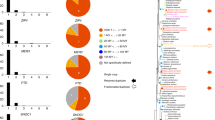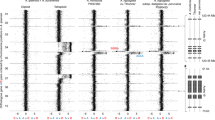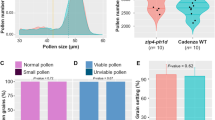Abstract
Triticum aestivum is an allohexaploid species originating from the hybridization of a tetraploid wheat and the diploid species Aegilops squarrosa. The tetraploid wheats are also allopolyploid species and were derived from a hybrid between a diploid wheat species and the diploid Ae. speltoides. The relationship of these three diploid species is such that, in hybrids between them, at first meiotic metaphase there is an average of approximately 3.5 bivalents from a possible maximum of seven1. On this basis some multivalent formation would be expected in amphidiploids derived from them, yet the usual meiotic disturbance in hexaploid wheat is univalent formation2. Classically, the regular bivalent formation and absence of intergenomic pairing in the polyploid Triticum species has been explained in terms of differential affinity, and in recent years it has been shown that differential affinity is enhanced by the activity of a genetical system on the long arm of chromosome 5B (refs. 3, 4).
This is a preview of subscription content, access via your institution
Access options
Subscribe to this journal
Receive 51 print issues and online access
$199.00 per year
only $3.90 per issue
Buy this article
- Purchase on Springer Link
- Instant access to full article PDF
Prices may be subject to local taxes which are calculated during checkout
Similar content being viewed by others
References
Kimber, G., and Riley, R., Canad. J. Genet. Cytol., 5, 83 (1965).
Riley, R., and Kimber, G., Heredity, 16, 275 (1961).
Riley, R., Chapman, V., and Kimber, G., Nature, 186, 259 (1960).
Riley, R., Heredity, 15, 407 (1960).
Riley, R., Kimber, G., and Chapman, V., J. Hered., 52, 22 (1961).
Author information
Authors and Affiliations
Rights and permissions
About this article
Cite this article
KIMBER, G. Estimate of the Number of Genes involved in the Genetic Suppression of the Cytological Diploidization of Wheat. Nature 212, 317–318 (1966). https://doi.org/10.1038/212317a0
Issue Date:
DOI: https://doi.org/10.1038/212317a0
This article is cited by
-
Marker utility of miniature inverted-repeat transposable elements for wheat biodiversity and evolution
Theoretical and Applied Genetics (2012)
-
Vorarbeiten zur monographischen Darstellung von Wildpflanzensortimenten:Aegilops L.
Die Kulturpflanze (1980)
-
Vergleichend-anatomische Untersuchungen im Verwandtschaftskreis vonTriticum L. undAegilops L. (Gramineae)
Die Kulturpflanze (1977)
-
The phylogenesis of protein ?-amylase inhibitors from wheat seed and the speciation of polyploid wheats
Theoretical and Applied Genetics (1976)
-
Introgression from diploid Aegilops speltoides to tetraploid durum wheat
Heredity (1971)
Comments
By submitting a comment you agree to abide by our Terms and Community Guidelines. If you find something abusive or that does not comply with our terms or guidelines please flag it as inappropriate.



